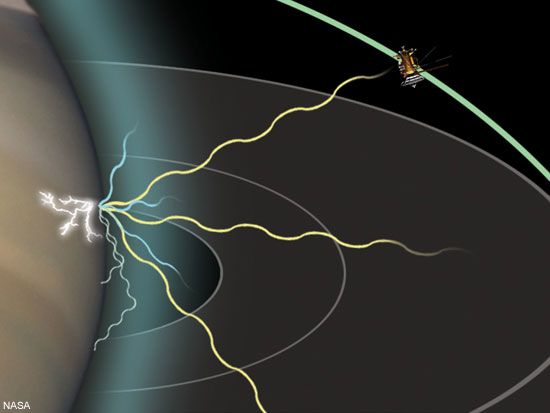Cassini Hears Puzzling Lightning at Saturn

Like Voyager before it, the Cassini spacecraft has detected lightning at Saturn, but it doesn't sound the same and scientists hope the episodic strikes will teach them something.
The NASA probe recorded the electrical activity on a radio receiver.
"We are detecting the same crackle and pop one hears when listening to an AM radio broadcast during a thunderstorm," said Bill Kurth, deputy principal investigator on the radio and plasma wave instrument from the University of Iowa. "These storms are dramatically different than those observed 20 years ago."
Voyager noted lightning from an extended storm system at low latitudes. It lasted for months and was much the same from one day to the next.
Cassini found lightning that is highly episodic. There are large variations in the occurrence of lightning from day to day, sometimes with little or no lightning. There are possibly several short-lived storms at mid-latitudes behind the readings, scientists said Thursday.
The root cause may be shadowy.
When Voyager visited Saturn, the rings cast a very deep shadow near the planet's equator. The atmosphere in a narrow band was permanently in shadow -- making it cold -- and located right next to the hottest part of Saturn's atmosphere. Turbulence between the hot and cold regions could have led to long-lived storms, scientists speculate.
Breaking space news, the latest updates on rocket launches, skywatching events and more!
Now it was summer in the southern hemisphere and the ring shadow is distributed widely over a large portion of the northern hemisphere. This causes the hottest and coldest regions to be far apart.
The Cassini observations could help scientists learn something about Saturn. The planet's ionosphere, a hot, ionized layer above the atmosphere, can block low-frequency radio waves. By measuring the lowest frequencies that can be detected by Cassini, scientists can determine the density of Saturn's ionosphere.
Cassini has made other findings, according to a NASA statement.
The craft discovered a new radiation belt just above Saturn's cloud tops, up to the inner edge of the D-ring. The belt extends around the planet. With this discovery, the radiation belts are shown to extend far closer to the planet than previously known.
"This new radiation belt had eluded detection by any of the spacecraft that previously visited Saturn," said Donald Mitchell, who works on the magnetospheric imaging instrument out of the Johns Hopkins University Applied Physics Laboratory. "With its discovery we have seen something that we did not expect, that radiation belt particles can 'hop' over obstructions like Saturn's rings, without being absorbed by the rings in the process."
The spacecraft is also tasked with exploring Saturn's 31 known moons, including Titan, the largest. Cassini's visual and infrared mapping spectrometer captured Titan glowing both day and night, powered by emissions from methane and carbon monoxide gases in the moon's extensive, thick atmosphere.
"Not only is Titan putting on a great light show but it is also teaching us more about its dense atmosphere," said Kevin Baines, science team member for the visual and infrared mapping spectrometer at NASA's Jet Propulsion Laboratory. "What is amazing is that the size of this glow or emission of gases is a sixth the diameter of the planet."
The Sun-illuminated fluorescent glow of methane throughout Titan's upper atmosphere -- revealing the atmosphere's immense thickness and extending more than 435 miles (700 kilometers) above the surface, was expected. However, the nighttime glow, persistently shining over the night side of Titan, initially surprised scientists.
"These images are as if you were seeing Titan through alien eyes," Baines said. "Titan glows throughout the near-infrared spectrum. If you were an alien it would be hard to get a good night's sleep on Titan because the light would always be on."
- Cassini Special Report

Space.com is the premier source of space exploration, innovation and astronomy news, chronicling (and celebrating) humanity's ongoing expansion across the final frontier. Originally founded in 1999, Space.com is, and always has been, the passion of writers and editors who are space fans and also trained journalists. Our current news team consists of Editor-in-Chief Tariq Malik; Editor Hanneke Weitering, Senior Space Writer Mike Wall; Senior Writer Meghan Bartels; Senior Writer Chelsea Gohd, Senior Writer Tereza Pultarova and Staff Writer Alexander Cox, focusing on e-commerce. Senior Producer Steve Spaleta oversees our space videos, with Diana Whitcroft as our Social Media Editor.
